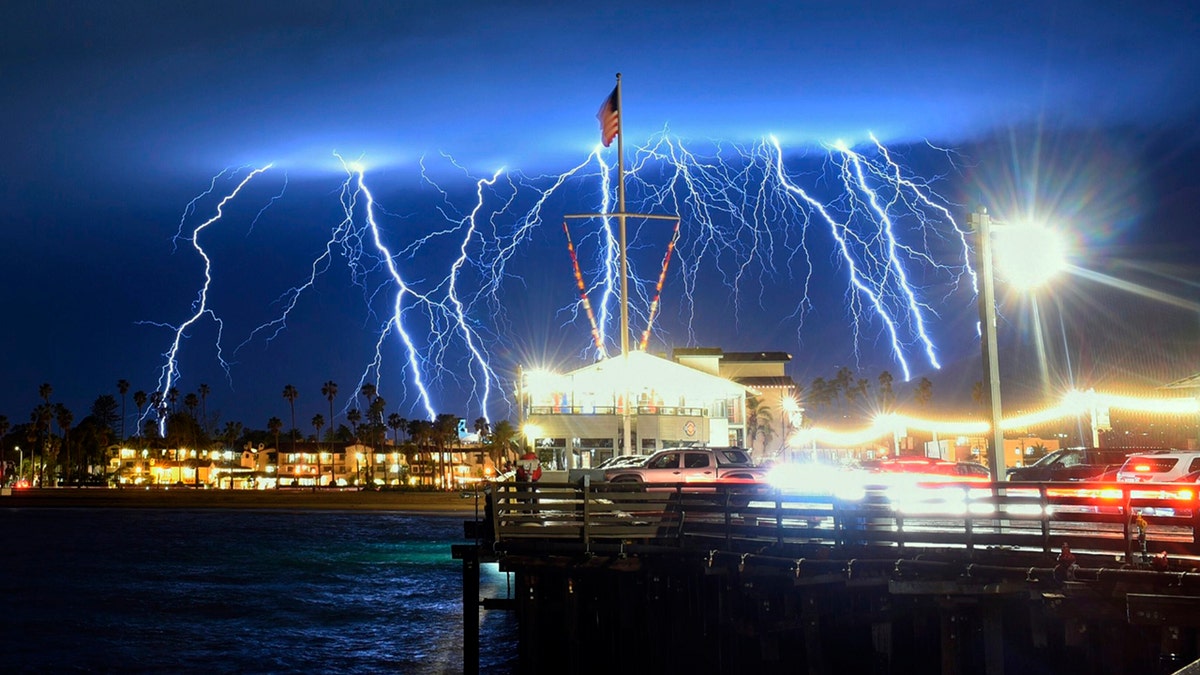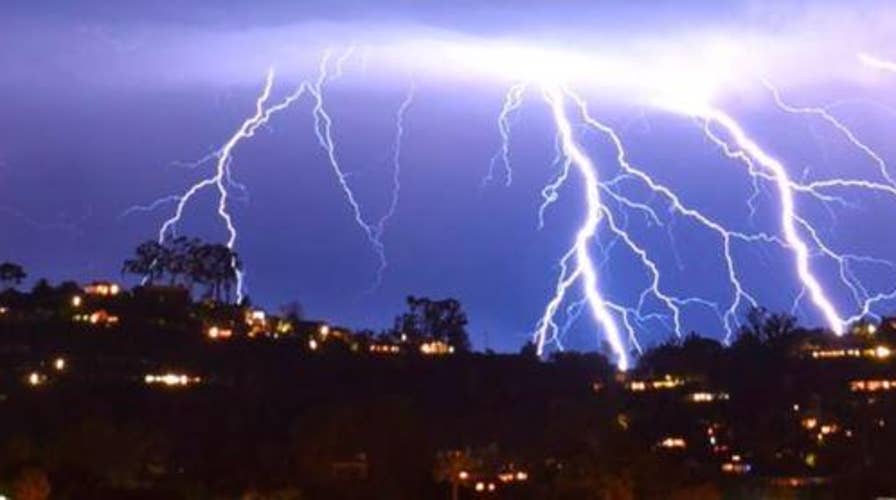Lightning strikes in skies across Southern California
Lightning strikes light up the Southern California sky as thunderstorms prompt mudslide warnings.
A powerful storm system was unleashing heavy rain for a second day Wednesday across Southern California -- after delivering a stunning lightning display in the skies over the region the night before.
The National Weather Service's office in Los Angeles said a weather system known as an "atmospheric river" was bringing isolated thunderstorms, along with heavy rain, flooding, and flash flooding to the region through Wednesday.
Lightning bolts illuminated the night sky late Tuesday, even causing a brief power outage at Los Angeles International Airport.
LIGHTNING BRIEFLY KNOCKS OUT POWER AT LOS ANGELES INTERNATIONAL AIRPORT, FORCES PLANE TO RETURN
Nearly 1,500 pulses of lightning were recorded off the coast in one 5-minute stretch, Kathy Hoxsie, a meteorologist with the NWS, told the Los Angeles Times.

This time exposure photo provided by the Santa Barbara County Fire Department shows a series of lightning strikes over Santa Barbara, Calif., seen from Stearns Wharf in the city's harbor, Tuesday evening, March 5, 2019. (Mike Eliason/Santa Barbara County Fire Department via AP)
“It’s a lot,” she told the newspaper. “We usually don’t get that.”
Time exposure photos posted by the Santa Barbara County Fire Department to Twitter showed the series of lightning strikes over Santa Barbara, Calif., including shots taken from Stearns Wharf in the city's harbor late Tuesday. There were an additional 231 pulses of lightning over Santa Barbara County and 40 in Los Angeles County, according to Hoxsie.

This time exposure photo provided by the Santa Barbara County Fire Department shows a series of lightning strikes over Santa Barbara, Calif., seen from Stearns Wharf in the city's harbor, Tuesday evening, March 5, 2019. (Mike Eliason/Santa Barbara County Fire Department via AP)
The NWS warned people to be careful watching the spectacle in the sky.
"Don't be a statistic!" the agency said.
The lightning from the storms forced a Delta Airlines flight to return to LAX after it was struck by lightning after takeoff. Delta Airlines Flight 2432 to Seattle returned to Los Angeles to be inspected after the reported strike, according to FOX11 reported.
No emergency was declared on board the aircraft and no injuries were reported, Charles Pannunzio of Los Angeles World Airports told FOX11.
The storm system is bringing up to 4 inches of rain is expected along the Central Coast, and amounts could be higher in areas where thunderstorms develop, the National Weather Service said.
The Santa Barbara County Sheriff's Office ordered 3,000 residents to evacuate hillside neighborhoods scarred by fires — including parts of Montecito hit by a disastrous debris flow just over a year ago. Officials didn't say how many people heeded the order.
CLICK HERE FOR THE FOX NEWS APP
The storm system that generated the storms is what's known as an atmospheric river, which the National Oceanic and Atmospheric Administration says is a huge plume of subtropical moisture.
"Atmospheric rivers are relatively long, narrow regions in the atmosphere – like rivers in the sky – that transport most of the water vapor outside of the tropics," NOAA states. "These columns of vapor move with the weather, carrying an amount of water vapor roughly equivalent to the average flow of water at the mouth of the Mississippi River.
The frequent storms this winter have nearly eliminated drought conditions in California. While frequently disrupting travel, the storms contributed a big part of the state's water supply — the Sierra snowpack that melts and runs off into reservoirs during spring and summer.
The Associated Press contributed to this report.





















